 Show Posts Show Posts
|
|
Pages: [1] 2
|
|
2
|
General Category / General Discussion / Re: Moldy smelling bark mulch - its disappeared!
|
on: August 23, 2010, 03:50:34 pm
|
|
During the past week, I've been walking around my property, checking out the plants and trees. While doing this, I noticed that the bark mulch didn't look like it should look. So I examined it more closely. Then I checked out all the areas I had put down bark mulch. To my great surrpise, all the bark mulch had disappeared, and all that remained was a thin coating of wood chips! I'd never seen this happen before. Normally I find that bark mulch will disappear, or rot, after a year or so. Now, its life seems to be two months!
Noticing this, at first I was almost in disbelief. Then, as I thought about it, it seemed to make sense. White canker infiltrates the inner bark of a tree, soaking up the nutrients that should instead go into nourishing and creating the outer bark. That nourishment includes the infusion of anti-decay chemicals into the outer bark. If you carefully examine trees infected with white canker, you will see that the bark often looks unhealthy, as if it is in a state of partial decay. This unprotected bark is what goes into bark mulch. Soil bacteria (and white canker fungus), then, has a much easier time of digesting this bark mulch, and it takes advantage of it, especially when moisture is present. The other component of typical mulch, wood chips, isn't attacked much by white canker, so it remains on the ground after the bark disappears.
I've always liked the look of bark mulch, along with its moisture retention. But it looks like I'm going to have to find a substitute. I've tried grass, cocoa shells and wood chips, but I'm not fond of any of the bunch. So I'm still looking.
|
|
|
|
|
3
|
General Category / General Discussion / Re: Fungicide resistance?
|
on: August 15, 2010, 05:12:42 am
|
|
Ah, yes, Cynthia Ash. She came to look over my trees and shrubs in 2005. She seemed very nice during the visit. But I later had some doubts about her diagnosis, and called to discuss them with her on the phone. She seemed very upset and somewhat angry that I would dare to question her, and she then refused to spend any more time with me discussing the subject! I was somewhat taken aback by this as I come from an engineering and science background, and try to seek out as much evidence as I can before coming to important conclusions. So it's no surprise to me that she "refused to look at your site". As for me, I'm willing to look at all evidence and to see where it leads.
Yes, I too am mystified by so many "experts" in the field giving a shoot-from-the-hip diagnosis when they have little to go on. It gives me the impression that plant pathology is more like a black art than a science! I like the statement made by the late tree expert Dr. Alex Shigo, who said something like "I listened to the trees, and I listened to the experts, and they disagreed - I decided to believe the trees".
I'd love to hear from Bill Stringfellow and discuss this disease with him. I'll let you know if he contacts me.
As I said in another posting, I'm not testing Agrifos, as I'm just now completing my testing with Propiconazole and Pentra Bark. I don't recall the mix ratio at the moment, but I believe I still have enough for two more treatments of my yard (about 25 shrubs and trees), which might do me for the season since I apply every 3 weeks or so. I think one cost me $12 and the other was $30, so that would be about $40-50 per season. Our local lawn and tree care company will do the spraying for you for about $100 per treatment, so maybe that would be something like $700 per season. That's fairly expensive (at least for me). But, you do also get insect protection thrown in when they do the treatment. On the other hand, I find that my combo treatment makes the trees healthy enough that they seem to be able to better defend themselves against insect pests, so I'm not seeing a need for insect control on my treated trees and shrubs.
|
|
|
|
|
4
|
General Category / General Discussion / Re: Chestnut blight?
|
on: August 13, 2010, 08:57:39 pm
|
|
Trunk splitting...
I'm still not certain what causes the trunk splitting in white canker. In fact, I don't recall ever reading why any canker caused bark splitting. But from what I've seen so far when examining white canker fungus within bark and under a microscope, it appears that there is a race going on between the phloem (inner bark) and the fungal material - each wants to gain the upper hand and dominate. This seems to lead to thickening of the phloem. At the same time, due to lack of nourishment, outer bark can't grow. The result seems to be a split in the outer bark.
Something in the soil...
Yes, its entirely possible that something in the soil can kill the chestnut fungus. Same with white canker fungus, as my website describes under the "Lazarous plant". This "something" may be some sort of bacteriophage - a virus that kills specific kinds of bacteria. I think that's also the ultimate answer for eliminating white canker. But right now it's just a wish. The people who support bringing back the chestnut trees (I'm one of them), are banking on selective breeding to come up with a blight-resistant chestnut tree. But I'm not hopeful that that will work with white canker, as it seems to infect virtually all trees and shrubs. The only thing totally resistant to white canker I've seen so far is viburnum leaves (but the wood/branches are highly susceptible).
Chestnut web page...
What impresses me about this web page is the willingness to freely discuss and try a variety of disease treatment approaches. A while back I spent many many hours doing Google searches for information on Sudden Oak Death (phytophthora ramorum). While I found many web pages dealing with it, the vast majority were simply rehashes of existing information. I found almost no information about people trying to treat it by experimenting with various fungicides. I found no pictures of what it looked like under a 400x microscope. While this disease was spreading rapidly, I found no discussion or experimentation on exactly how it propagated/reproduced. Most sites seemed content to just publish pictures on what affected trees looked like, and how bad it was.
Agrifos...
I haven't tried Agrifos, so I have no idea on its effectiveness on white canker. I really only have the means to try one fungicide at a time. Right now I'm testing a Propiconazole and Pentra Bark combination as a "trunk drench". I've tried about 4 or 5 treatments over the summer on my trees and shrubs, and on two of my relative's trees and shrubs. Experience so far shows it to be successful, so I plan to publish details on this website soon. Possibly next summer I'll try something else, such as Agrifos and Pentra-Bark. My goal is to find something that is relatively low cost, easily applied, doesn't damage the trees, and is not a threat to people, groundwater, or animals.
|
|
|
|
|
5
|
General Category / General Discussion / Re: Our evaporating silver maple trees
|
on: July 30, 2010, 09:40:36 pm
|
If you've looked closely at many silver maple trees, you know why they call them "silver" - their bark is a silver color. And you've also probably noticed that the bark is shaggy and covers the entire trunk of the tree. White canker makes this description less true now. One characteristic of white canker is that it eats away at the inner bark, the phloem, and prevents the creation of new outer bark. Furthermore, chemicals that protect the outer bark from decomposition are also not produced. So, as a tree grows, the old bark decays away, and instead of new bark you get a poor substitute. In addition, the loss of chemical decay resistance means lichens are more likely to colonize the bark. The previous posting mentioned this bark issue. This posting will show you some examples of it. Here's the first example: 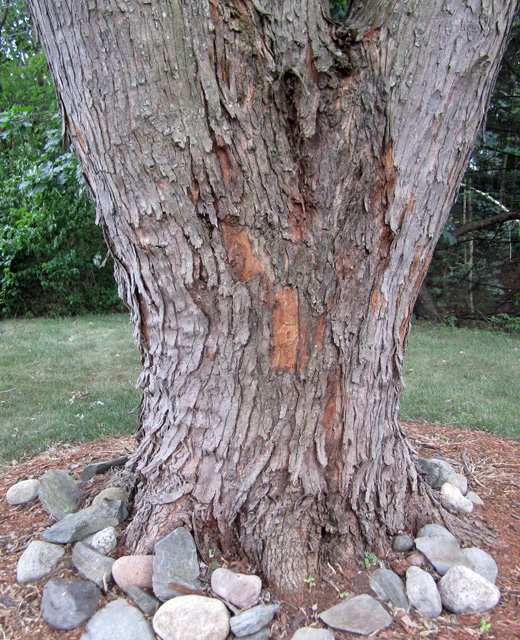 To see a full-resolution version of this photo, click on www.whitecanker.net/pictures/2010-07-25 Silver maple-1 bark.jpg(Left click to zoom in to a point, right click to save the picture to your PC or to print it.) The first time you notice this, you will probably think somone has peeled the bark away. But then, as you more carefully examine these bare spots, you'll see that the underlying bark doesn't look healthy at all. Here's another silver maple with the same problem: 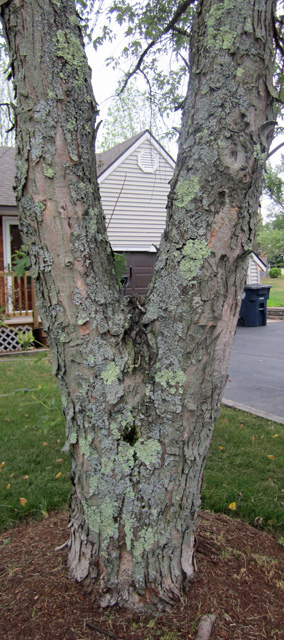 To see a full-resolution version of this photo, click on www.whitecanker.net/pictures/2010-07-25 Silver maple-2 bark.jpg(Left click to zoom in to a point, right click to save the picture to your PC or to print it.) As you look at the remaining bark, you can see that it is losing its silver color, and instead turning black. The areas where the bark has fallen away often take on a light brown, or "peanut butter" color. This silver maple hasn't lost too much bark yet, but it's getting there. 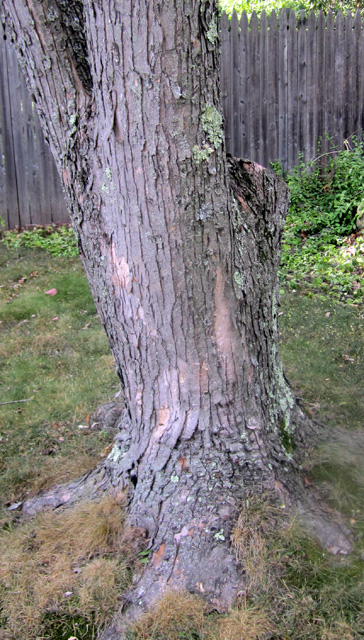 To see a full-resolution version of this photo, click on www.whitecanker.net/pictures/2010-07-31 Sick Silver Maple - 19 Briand.jpg(Left click to zoom in to a point, right click to save the picture to your PC or to print it.) This silver maple has lost more bark, and the lower area of bark loss even looks a bit rotten. In fact, if you look closely, the upper-left part of the trunk shows some signs of bleeding. 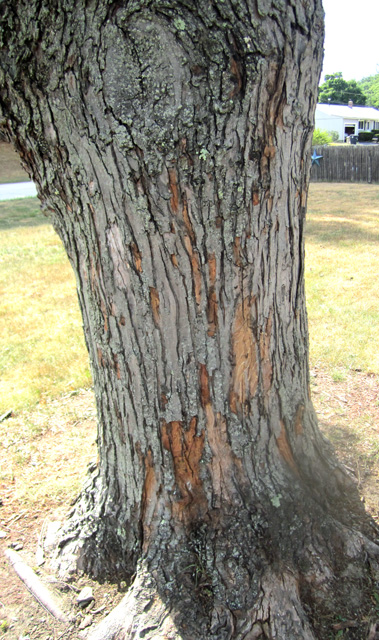 To see a full-resolution version of this photo, click on www.whitecanker.net/pictures/2010-07-31 Sick Silver Maple - 25 Briand.jpg(Left click to zoom in to a point, right click to save the picture to your PC or to print it.) This large silver maple has lost quite a bit of bark from its lower trunk. The bark loss has gotten progressively worse the past few years. 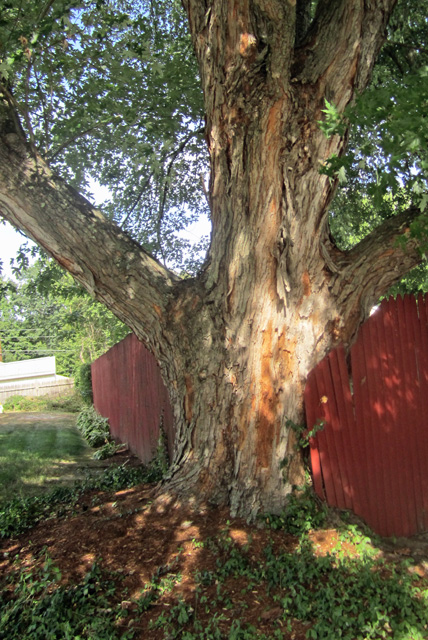 To see a full-resolution version of this photo, click on www.whitecanker.net/pictures/2010-07-31 Silver maple - 6 Sanborn.jpg(Left click to zoom in to a point, right click to save the picture to your PC or to print it.) So, over time, people may begin to wonder why these trees are called "silver" maples! |
|
|
|
|
6
|
General Category / General Discussion / Our evaporating silver maple trees
|
on: July 26, 2010, 05:11:06 am
|
If you've looked at as many silver maple trees over the past few years as I have, you may have noticed that they are changing in appearance. There appear to be two significant changes taking place. The first change is in the bark - it isn't as "silver" as it was in the past, and it seems to be falling off in spots, being replaced with a brown "under bark". The other change, responsible for the title of this posting, is that the canopy is getting thinner and thinner, and some leaves are turning yellow, curling up, and dropping off. Often the leaves will drop off a branch successively from the base to the tip, leaving just the branch tips with leaves. Note that this is NOT the typical "tar spot" that is causing this. Here is a picture of a stressed neighborhood silver maple tree: 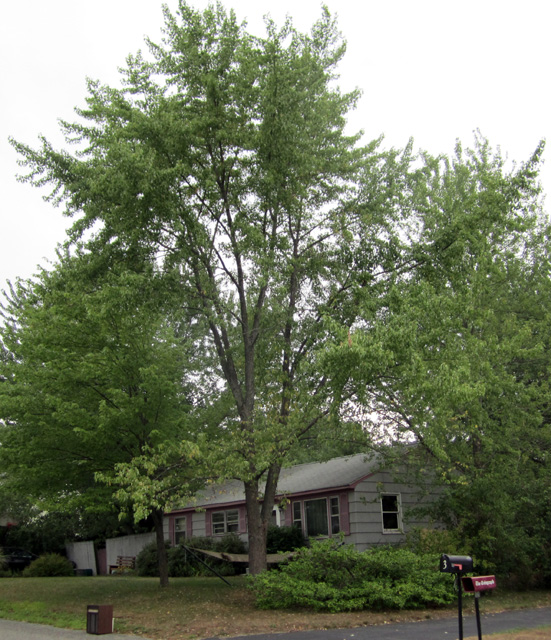 Given a quick glance, you'd think this tree is healthy. But note the yellowed leaves on the lower-left branch. Some of the leaves on this branch have curled up, turned brown, and fallen off. It's from this branch that I took a sample twig. Since a twig cross-section usually tells a lot about the condition of the tree, I took a series of 45 digital microscope images of the bark edge at 400x and stitched them together with Microsoft's ICE program, yielding the following composite image: 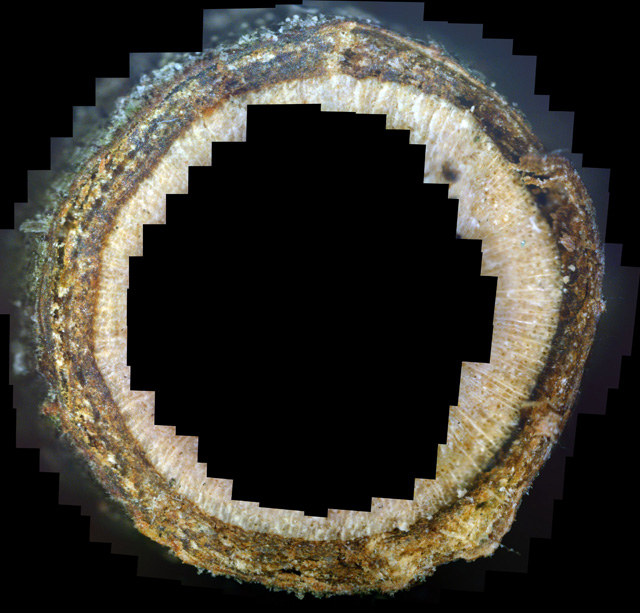 To get an even better appreciation of what this picture shows, check out the full resolution picture at: http://www.whitecanker.net/pictures/2010-07-25 Composite Silver maple twig cross-section.jpg (Click on a feature to zoom-in to it.) First and foremost, note the almost complete lack of green phloem, the tree tissue that transports the tree's nutrients! Instead, this green phloem has been replaced by dead tissue and white fungus material. It's no wonder the leaves are curling up and dying as if they are starving for water - they are! But watering the ground around the tree probably wouldn't do much good at all, as there is almost nothing left transport this water to the leaves. In addition, check out the xylem tissue below the phloem. It should be milk-white, but instead is a light brown, as if it, too, is dying. The large quantity of white blobs mixed in with the normal bark tissue give a strong indication that this tree is dying of white canker. |
|
|
|
|
7
|
General Category / General Discussion / Re: Our beautiful red maples are dropping dead
|
on: July 24, 2010, 09:27:13 pm
|
I saw another red maple that looked in sad shape, and decided to take a much closer look at it. Here it is: 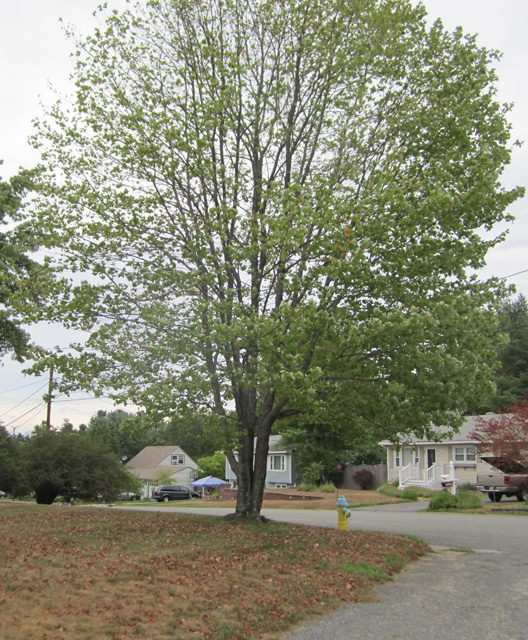 Although there is only a dead branch or two, as you can see, the foliage is very sparse, and many leaves have already fallen. Curiously, the right side of this tree is mainly south-facing, so gets most of the sun. Apparently the sun's energy is helping keep this tree going. Except for the leaves drooping and being rather small, I saw no canker on the top or bottom surface of them. But the bark was another matter. Actually, as is typical, most of the bark is clean. However, there were extensive patches of spores at the underside of branch junctions, as shown in the following branch surface microscope photo taken at 400x: 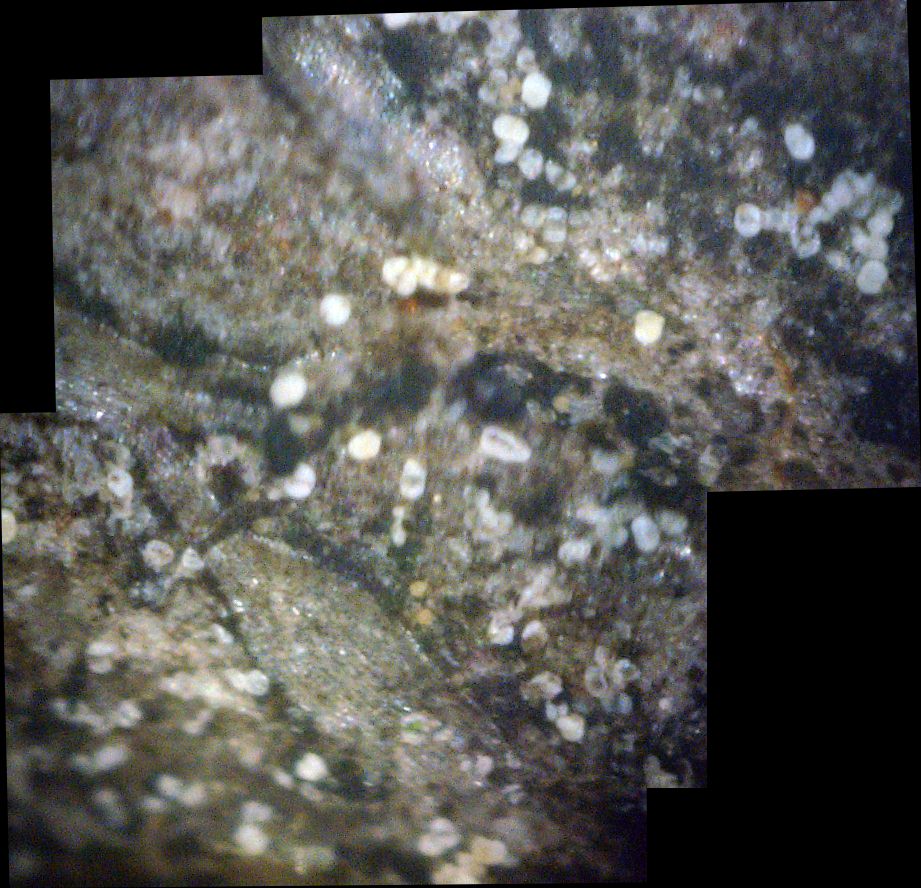 Once again, the white spores are about 50 microns in diameter and the smaller yellow spheres are about half that size. If white canker is really present, some of the best evidence is a detailed view of the cross-section of a twig or small branch. This time I took a quarter-inch diameter branch as a sample. Using my digital microscope, I then carefully took about 60 overlapping photos at 400x around the edge of the cross-section so I could capture all of the area just under the bark. I then used Microsoft's ICE photo stitching program to compose one large image. A small view of it follows: 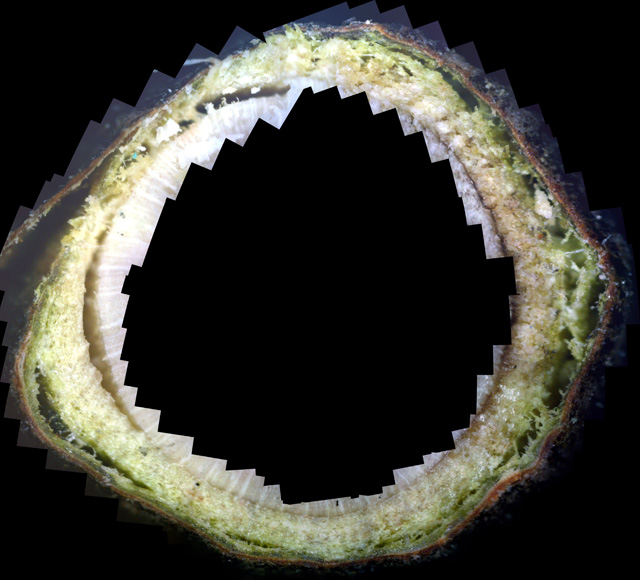 This photo shows of how badly this tree is diseased. Only a trace of the normally green phloem is present, having been replaced by white canker material. The bark is separating from the phloem, as if it is trying to get away from it. Only a very thin layer of phloem remains immediately under the bark, and even there it only extends about half-way around. I've also made the full-resolution photo available on this website - check it out by zooming into it, at: www.whitecanker.net/pictures/2010-07-24 Maple branch cross-section donut.jpg (Right click the picture to save it to your PC or to print it.) As you zoom-in to examine the details, you'll gain a better appreciation of how devastating this disease is to the inner part of the tree. The chaos there reminds one of a war going on. And, in fact, there is. You'll note that these photos don't include the central xylem, which is usually a boring white. You can see the edge of it in the above photos. However, white canker does infect this xylem. Apparently it has killed part of the xylem in the center of this branch, as the following stitched photomicrograph shows: 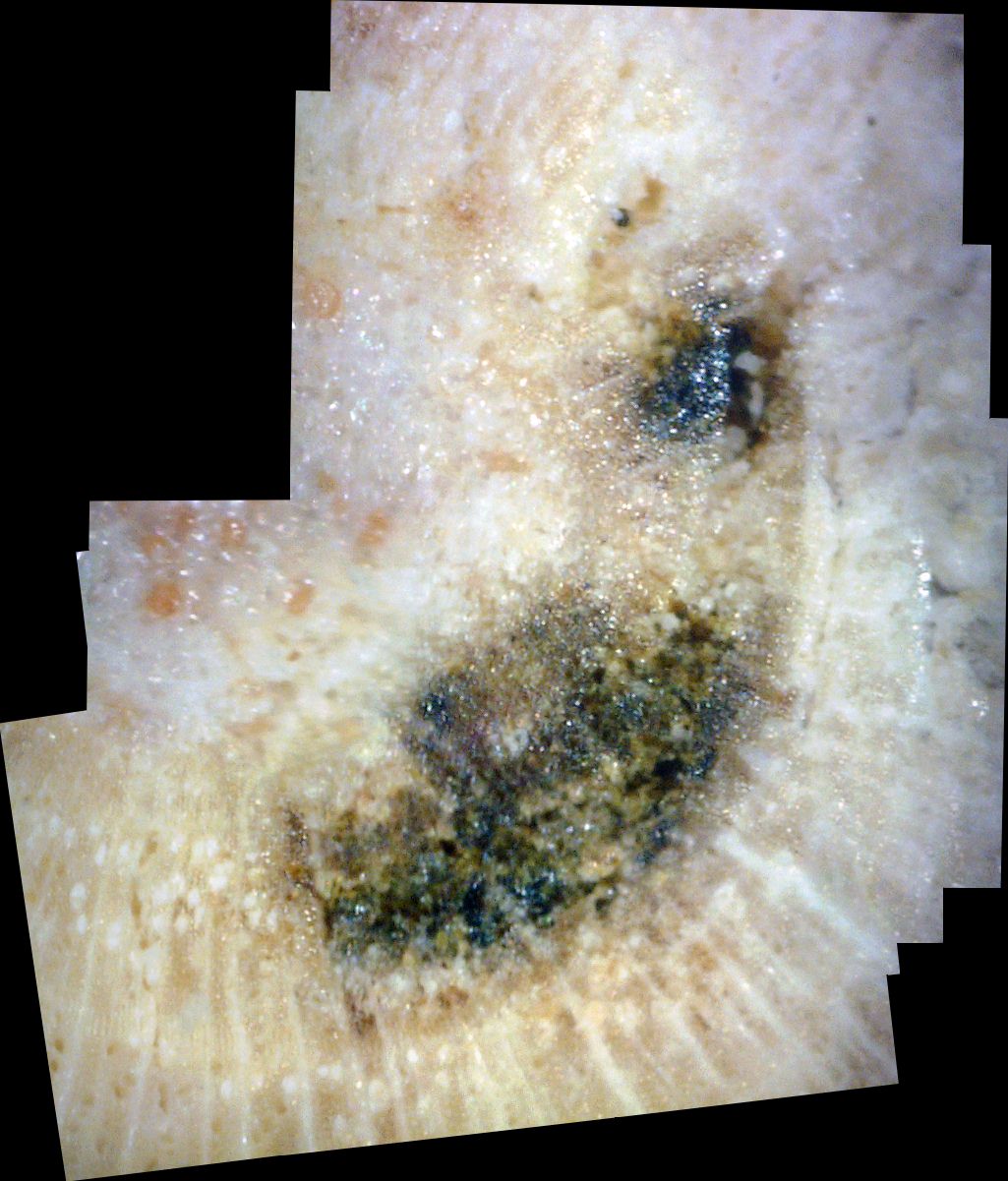 The reason I suspect white canker killed this tissue is that there appears to be white canker within and around this black tissue. Not only that, but to the lower-left of this dead area is a patch of white canker blobs. Apparently, when the white canker density gets high enough, it kills off the white xylem tissue. Furthermore, as the snow-white xylem begins to die, it seems to turn brown, further highlighting the infiltration of white canker blobs. |
|
|
|
|
8
|
General Category / General Discussion / Re: Fungicide resistance?
|
on: July 22, 2010, 09:50:12 pm
|
Pentra-Bark doesn't cost that much, actually. I found a few sources on the Internet, but ended up buying mine from treecaresupplies.com for $24 USD per pint. It was worth it to me to get the satisfaction of treating my trees and shrubs myself. Actually, I'd describe the white canker sporangia as roughly spherical, milk-white, about 50 micrometers in diameter, and almost always having two distinct lobes, sometimes with a touch of yellow between the lobes. They rest on a stalk that is only about 5 micrometers high and a few micrometers thick, so this stalk is very difficult to see as it is almost always hidden by the sporangia above them. I wish I could treat once and be done with it  I began my treatment study by having a commercial lawn & tree care company do my trees. Of the four fungicides they tried, only Propiconazole and Mancozab were effective. And after about three weeks I noticed the white canker symptoms returning. Plus, these fungicide treatment company directions say to treat every 3 weeks or so. They're right! According to the directions, the fungicide doesn't kill the fungus, it just prevents it from making new cell walls. Its up to the trees to keep up the battle. A healthy tree can often live for many years with a white canker infection. After all, a well-seasoned fungus doesn't want to kill off the host that feeds it! Yes, you can post pictures in this forum, as you can do in most forums. In fact, I just posted a note on our red maple trees dying, and that posting contains two pictures. Limit your picture size to 1024x768 pixels. The catch is that you have to place your pictures on some website, and then reference the pictures with a full URL (use the Preview button to verify you have it right). So you'll have to find some picture hosting website. Same with PDF files (although there is no size limit). |
|
|
|
|
9
|
General Category / General Discussion / Our beautiful red maples are dropping dead
|
on: July 22, 2010, 09:23:49 pm
|
Here in New England, one of the most beautiful times of the year is in the fall, when the leaves turn color. And many would say that the most colorful trees in the fall are the red maples, which often turn a bright red. But these maples have been declining the past few years. There was one in our housing development which my wife and I agree is the best of the best - it turns a bright crimson red in the fall. We check it out every year. It has always seemed to resist attack by white canker. But last year I noticed the leaves sagging a bit more than usual. I was hoping it was just my imagination. Unfortunately, this summer there are a lot of its leaves dropping. Numerous branches within the canopy are dead. But, true, we are having a very warm and dry summer. But other red maples are also showing signs of severe stress. In fact, one of my neighbors has one, and within a week every single leaf on it died! I had been following this tree. Several years ago a windstorm broke the top off, and soonafter it seemed to acquire some symptoms of white canker. (I assume the white canker spores got in through the large wound.) But I never expected such a sudden dieoff. Here's a picture of the tree: 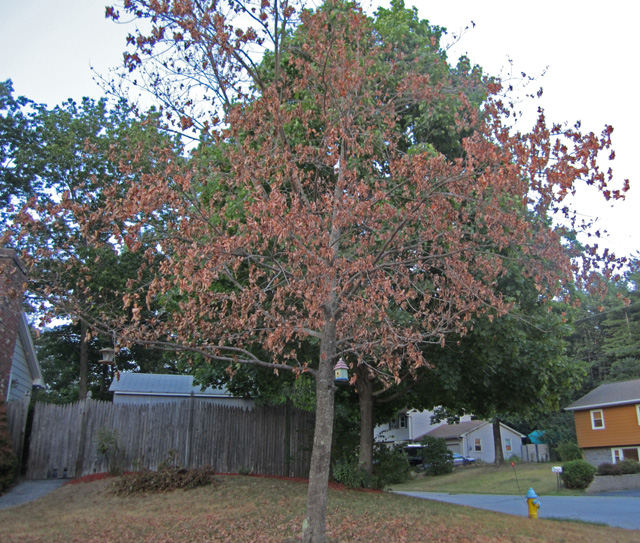 Of course, by simply looking at this tree you don't get much insight as to why it died. So I broke off a small 1/8" (3mm) diameter twig, cut it with a razor, and then looked down into its cross-section with a 400x digital microscope. I took 20 pictures all around the periphery of the twig, and then used Microsoft's ICE picture stitching software to combine them all into one picture, which I include here: 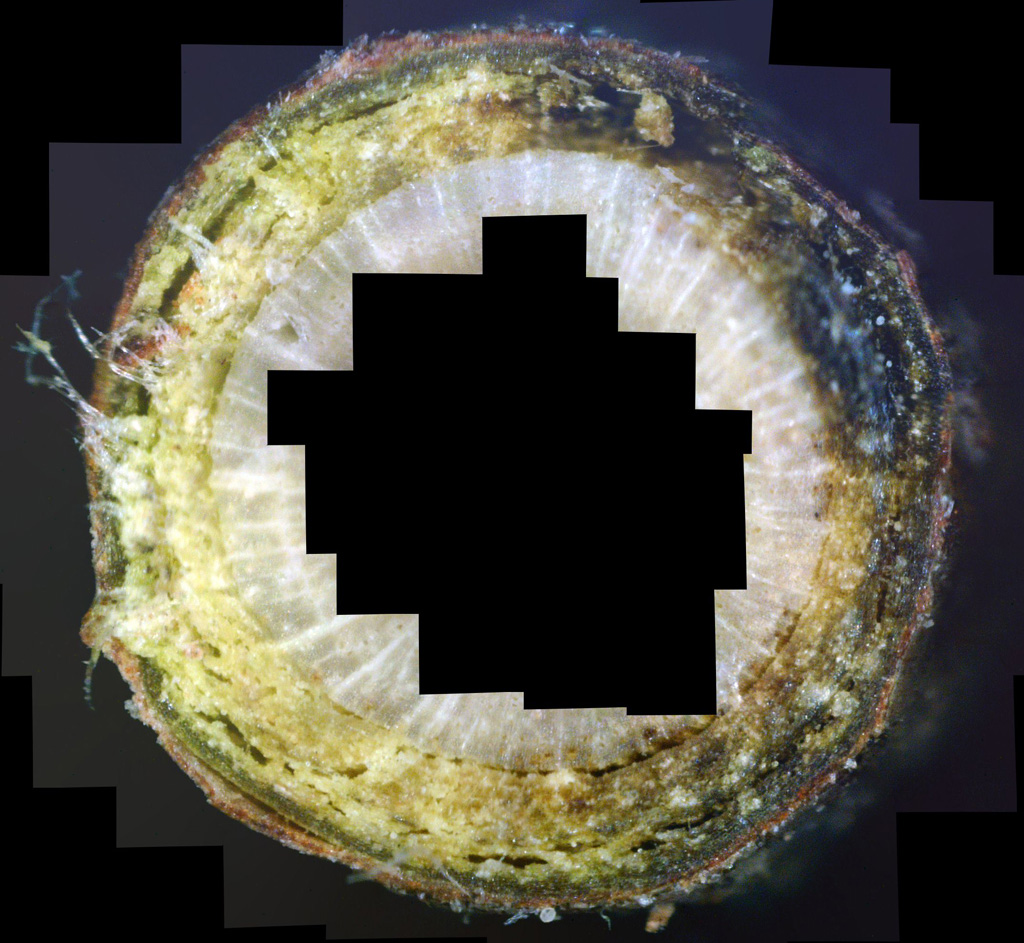 (The inner white xylem is not shown since its not diagnostic.) As you can see, there is only a trace of the green phloem left under the bark (lower-left). Almost all the phloem has been infiltrated by a white fungus, so the normally green phloem is now more white than green. You can see the fungus almost oozing out from under the bark on the left side (hair-like translucent strands). The right half of this twig has started to die, and is turning black. I suspect the reason this tree died suddenly was that it was just barely hanging on because its nutrient carrying system in the phloem was almost totally clogged with fungus. The recent heatwave combined with a relative lack of water simply pushed it over the edge. Will it come back? Often times when a tree is hit with a massive defoliation, as with insects, it will refoliate within weeks, although this takes a severe toll on the tree's energy supply. In fact, the branch I sampled does have very small green leaf buds. But the severe damage to the green phloem argues for no comeback, or a very weak comeback. Meanwhile, will the homeowners give up on the tree and cut it down? Stay tuned... (this is the third week in July - the hottest time of the year) |
|
|
|
|
10
|
General Category / General Discussion / Re: Fungicide resistance?
|
on: July 21, 2010, 05:28:03 am
|
|
Thank you for the feedback Colleen. This website gets a fair number of visitors, but for some reason people don't post in this forum (except for spammers - I'm wildly popular with them for some reason!).
You're right-on when you say a very wet spring brought on more symptoms. White canker is a fungal disease that thrives on moisture either on the bark of a shrub or tree or just under the bark (in the green phloem nutrient transport system). Its growth is more vigorous in these locations. Propagation via spores takes place on the bark surface.
Your symptom observations on a variety of trees agrees exactly with what I'm seeing. For example, white birch trees, which were fairly common around here in years past, now are becoming a rather rare sight - especially healthy birch trees. Most seem to be dead or dying. Yet no one seems to be noticing it. I'm guessing that nobody is noticing this because the die-off is taking place over a several year period. This disease is usually not a quick killer.
What I REALLY wish some people would do would be to look at the leaves and twigs and bark of these diseased trees/shrubs under a 400 power microscope so they could actually see that the inner bark is being eaten away by a fungus, as if it is being dissolved by an acid.
My fungicide effectiveness studies still stand. However, my tree-care company recently increased prices dramatically. So I'm now experimenting with treating my trees and shrubs myself. There is no way I can reach the top to tall trees, or most trees, so I'm trying another approach: I mix the systemic fungicide I found effective (Propiconazole) with a chemical that helps it penetrate the bark, and then spray this mixture all over the trunk, from ground level to about 5' high. It's called a "trunk drench". I just started testing it this summer, and so far it's very effective. Trees that were previously dying are now nice and healthy. But since this treatment doesn't kill the fungus (according to the fungicide manufacturer, it just keeps the fungus from building cell walls), you have to repeat treatments every 3 or 4 weeks. I'm probably going to post more details in another note, e.g., exactly which trees & shrubs I treated and exactly what effect it had.
Yes, using a variety of fungicides would be ideal. Unfortunately, I don't have the means of evaluating a wide variety of fungicides - I can only evaluate what commercial tree care companies use. Plus, some fungicides may have harmful effects on pets, plants... or us! I was hoping that others would test other fungicides and post the results on this website. But nothing so far. I guess people in general still don't really believe there is such a thing as this white canker fungus. Even our state university plant pathologist doesn't believe it!
Oh, I should say that during a wonderful tour of Mt. Auburn Cemetery, in Cambridge MA (which has a huge variety of trees), it was pointed out that some beech trees were in a state of decline (sure looked like white canker to me), and that Cornell was trying an experimental treatment. I got the name of the researcher there, called him, and found that they were doing "trunk drenches" using a chemical call Agri-phos, along with a bark penetrant. I was surprised to find out how similar our treatments were! As far as I know, since they are still in a testing mode, nothing about its effectiveness has been published.
I don't know if the name "white canker" will stick or not when it becomes more widely known. But it needs some name until we come up with a better name, or until some lab identifies exactly what kind of fungus it is. Right now, most experts are dubious about this disease when I say that it attacks almost all trees and shrubs to some extent. Strangely, none of the experts I've contacted seem to have an interest in looking into it. When pressed, they say they "don't have the time" to review the evidence!
For those who really care about the health about their trees and shrubs, I hope this website helps.
|
|
|
|
|
11
|
General Category / General Discussion / Why are Pine Trees Dropping their Needles?
|
on: July 21, 2010, 12:23:19 am
|
If you live here in the the Northeast United States, you may have noticed that pine trees have been dropping their needles this summer, when they should be doing that in the fall. This issue was discussed recently in a UNH Cooperative Extension Education Center Newsletter article, where the needle drop was referred to as "epic". Curious as to exactly what is causing this disease, I took it upon myself to gather more factual information regarding this apparent tree disease. Specifically, I examined a red pine and three white pines, recording damage to the outside bark, inside bark, needle surface, and needle interior. What I found does not appear to match the symptoms of known pine diseases, specifically needlecast. Vermont officials seem to agree that we may be seeing something new, saying that this disease is still "under investigation". All the disease data I've gathered on this pine disease is detailed in a set of over 40 photos contained within this website PDF file: www.whitecanker.net/Pine needle drop analysis.pdf. Most of the photos were taken with a digital microscope so you can see exactly what sort of damage this disease is doing within the tree, as external views don't tell you much. Remember, PDF viewers have the ability to zoom in to content, so you may want to use this feature to more closely examine some of the photos. If you have additional information regarding this pine tree disease, I'd love to hear from you! In fact, we can all discuss it. Just reply to this note. Don Peters Nashua, NH |
|
|
|
|
12
|
General Category / General Discussion / Moldy smelling bark mulch
|
on: July 17, 2010, 04:52:33 pm
|
|
I've been using bark mulch in my yard plantings for over 35 years. I've used it for a variety of practical reasons: looks, moisture retention, weed control, and erosion control. But another reason is that I simply enjoy handling it and putting it down. In fact, I often use both hands to grab a bunch of it, and then smell it before I place it. I find the smell of bark mulch to be very aromatic, and think of it as nature's perfume. I've talked to other guys who feel the same way.
No more. I recently had a truck load of bark mulch delivered. I checked its smell periodically, and instead of finding it pleasant, I found it repelling. So much so, that I actually tried to avoid getting my face near it.
When I ran out of this mulch, I picked up a few bags of hemlock mulch at our local Home Depot. The brand was Timberline, and was the dark variety. I thought hemlock would smell better. But it was worse. The smell in all cases was of strong moldy odor. None of the past bark aroma was there at all.
My mulch needs were greater than I thought, so I want back for more. Home Depot was out of the blue Timberline hemlock mulch bags, so I bought their bags of hemlock mulch that had red coloring on the outside. The mulch inside was of a red color. The mold smell was still there, but not as strong, and there was only a faint appealing bark aroma. I tried calling the Timberline manufacturer, but no one answered their 800 number. So I called their local number. No one answered, so I tried to leave a message, but their answering machine cut me off saying it heard no audio! So I tried to contact them via the Internet. Fortunately, I received a nice reply from their agent Kathy Perron, who said the hemlock came from "hemlock bark and composted forest products" in Maine (the next state over). The red mulch isn't really bark mulch (the bag calls it "Hemlock Mulch"), and is made from "softwood logs, ground and dyed with a carbon based dye". In summary, it cost more, had a slightly better texture, and less of a mold odor.
Unfortunately, my wife absolutely hated the redish color of the mulch (I liked it, thinking it was more of a red-tinted brown then red), so I went back again to Home Depot and this time bought Scott's mulch, made from forest products. This mulch also had a somewhat moldy smell with almost no pleasant aroma. It was also dyed - a nice "deep-forest" brown.
Consequently, after all this experience, now when my nose gets near this (bark) mulch, I hold my breath so as to avoid smelling it. What a shame.
So, why the change in bark aroma? I'm guessing it's due to white canker. Here's why. While white canker does infect leaves, microscopic examinations show it is primarily a bark disease. More specifically, white canker fungus feeds on the nutrient-rich inner bark, destroying it. While destroying it, the fungus prevents nutrients from migrating outward toward the outer bark. You can see this on the bark surface of infected trees - new bark often doesn't get created, and existing bark is cut off from the chemicals (often aromatic) that prevent other fungus from attacking and consuming it. In fact, bark on infected trees will simply look unhealthy, as if it is decaying. It is.
When such an infected tree is cut for lumber, the unhealthy, decaying bark is stripped off and ground up to produce bark mulch. This bark mulch therefore strongly smells of mold/fungus precisely because it contains a large amount of it.
A closely related issue is whether this infected bark mulch will damage the plantings it resides among. I don't think it's harmful, and so far I haven't seen any harmful effects. After all, all bark mulch will eventually decay naturally anyway. This natural decay is now simply given a head start, so the bark mulch probably won't last as long as expected. In fact, I'm seeing this now - the bark mulch I put down several weeks ago seems to be disappearing!
As do many others, I love the look of bark mulch. But based upon my experience with it combined with my research into white canker, I'd recommend avoiding "bark" mulch, and instead go with mulch composed of ground up wood, since the interior of a tree is usually not much affected by white canker.
Damn, I miss that sweet bark aroma!
|
|
|
|
|
13
|
General Category / General Discussion / Re: Sour apple cider due to white canker?
|
on: September 29, 2009, 09:03:51 pm
|
|
Here's an update, since the Fall 2009 apple cider season is now here. I picked up two different brands of apple cider at the local Hannaford's supermarket and tried them both.
The first, from Ricker Hill Orchards in Maine, was the most tasteless apple cider I've ever had. More specifically, it tasted like apple cider that had all the sweetness removed, leaving a watery, tart, woody taste. In fact, I dumped about half of it down the drain rather than finish drinking it.
The second, Rudy's Blend, from Carlson Orchards in Harvard, Massachusetts, was better, with more of the expected flavor. I had bought this brand for the past few years and found it to have a good flavor. But this year again its flavor was lacking, as if a good amount of the natural sweetness was missing.
Because both brands were bought in a supermarket, I assume they were both pasteurized. I find non-pasteurized apple cider to have a more natural taste, but you can only buy it at farmstands that sell directly to the public. I hope to try some in the next month or two.
|
|
|
|
|
14
|
General Category / General Discussion / Blue Spruce dieoff
|
on: February 17, 2009, 06:23:57 am
|
One of the most common and beautiful trees homeowners plant in their yards is the Blue spruce, so named because of its blue-green needles. These trees also have a lovely pyramidal shape, have dense foliage, and are easy to care for. Unfortunately, they seem to be dying off. You won't notice it unless you stop to periodically examine the health of these trees. The decline started gradually several years ago around here (New England), with only a few trees being affected. This year I've noticed that nearly every Blue Spruce is in serious decline. Here are the symptoms: - The lower half of the tree shows the vast majority of decline.
- The branches on the lower half of the tree begin to "pancake", collapsing onto lower branches. This leaves "holes" in the normally dense foliage.
- The very symmetrical look of the tree is altered by occasional branches sticking out further than usual.
- Needles, especially on smaller inner branches, turn brown and fall off. If there is snow on the ground, you can often see its surface covered with dead needles. If there is no snow, try shaking a branch - you will likely see needles fall like rain.
- Needles on the branches about a foot from the tip begin to take on a slight yellow-brown tinge.
- Where you could never see the trunk of the tree before due to foliage density, the trunk now begins to be easily visible as bare branches become more common.
- As all these symptoms progress, the beautiful blue-green color of the branch tips fades, and you find yourself wondering if this is really a "blue" spruce!
As you can see, the progression of this disease causes Blue Spruce trees to lose all the attributes that homeowners love about this tree. Along with this may come the temptation to cut the tree down. A few other notes: - Younger trees (under 15 feet tall) seem to resist this decline better than more mature trees.
- As my research shows (see the information on Blue Spruce), the likely cause of this decline is White Canker. Strangely, however, while a key indicator of White Canker is bark splitting, spruce trees having White Canker show no evidence of bark splitting.
- Since I have no Blue Spruce trees in my yard, I'm unable to tell if the fungicides that are effective against White Canker will have an effect on Blue Spruce trees.
- While I have yet to see a Blue Spruce that has died from this disease, I have seen a few that are about 30% defoliated, and, if anything, the decline seems to be accelerating. At this rate, I expect to see 90% defoliation within about 4 years.
So the next time you pass by a Blue Spruce tree, check it out and see if you find any of the disease symptoms listed above. Post your observations here. Oh, and be sure to note what part of the country you are from.Don Peters Moderator |
|
|
|
|
15
|
General Category / General Discussion / Sour apple cider due to white canker?
|
on: January 10, 2009, 01:49:15 am
|
|
One of my favorite drinks is apple cider. I mean "unpasteurized" apple cider, which by
law (here in New Hampshire) can only be sold at farm stands. I've been drinking it for
years because it has such a rich, sweet and intense flavor.
But not this year. The sweetness seems to be missing. At first I thought the reason was
that I bought it too early in the season. But the taste of it didn't seem to change
from early to late fall. I almost decided not to buy it in the future.
Puzzled about why the sweet flavor should be missing, it occurred to me that I might
already know the reason - white canker.
To build a nice sweet apple, the tree must supply the apple with plenty of sugars. These
sugars come from photosynthesis, which takes place in the leaves. The sugars have to
be transported from the leaves to the apples. This is done via the phloem layer, which is
a thin layer of tissue just under the bark. It is this tissue which is rich in nutrients.
But check out all the microscope photos of white canker. You'll see that white canker,
like any successful organism, goes right for the food supply, using this food for its
own growth. So the sugars, instead of feeding the apples, are feeding the white canker instead.
Consequently, we don't get the sweets - the white canker does.
Now, I can't be sure this is the cause of the non-sweet apple cider. More research will
have to be done. But the damage done by white canker sure seems as if it is a likely cause!
|
|
|
|
|



